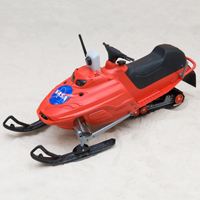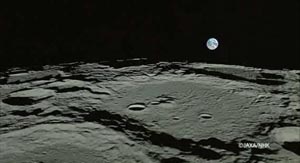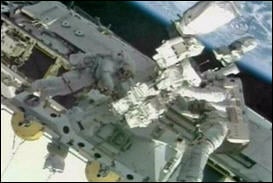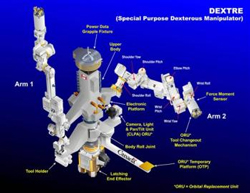Latest Gear Live Videos
Scientists Believe Mars May Sustain Veggies

Posted by Sheila Franklin Categories: Science, Transportation,
 Now that the Phoenix Lander has found possible evidence of ice, scientists are even more optimistic now that they have taken soil samples that shows a high alkaline level. Sam Kounaves, lead investigator for the wet chemistry laboratory, claims “It is the type of soil you would probably have in your back yard, you know, alkaline. You might be able to grow asparagus in it really well ... it is very exciting.”
Now that the Phoenix Lander has found possible evidence of ice, scientists are even more optimistic now that they have taken soil samples that shows a high alkaline level. Sam Kounaves, lead investigator for the wet chemistry laboratory, claims “It is the type of soil you would probably have in your back yard, you know, alkaline. You might be able to grow asparagus in it really well ... it is very exciting.”
The soil also showed traces of sodium, potassium, and magnesium, among other elements. We are not so sure it is all that exciting. How many people do you know that want to grow asparagus?
Read More  | Couriermail
| Couriermail
Advertisement
Is There Ice on Mars?

Posted by Sheila Franklin Categories: Editorial, Rumors, Science, Transportation,
 NASA believes that material found on Mars recently may really be ice. When images from the trench dubbed “Snow White 2” were received from the Phoenix Mars lander, scientists believed the white surface shown was either salt or ice clumps. Because many of them were gone the next day, the researchers ruled out the presence of salt, although the soil sample didn’t yield evidence of water.
NASA believes that material found on Mars recently may really be ice. When images from the trench dubbed “Snow White 2” were received from the Phoenix Mars lander, scientists believed the white surface shown was either salt or ice clumps. Because many of them were gone the next day, the researchers ruled out the presence of salt, although the soil sample didn’t yield evidence of water.
Because the Phoenix is undergoing adjustment to its software, it has been a bit lax in its duties. We suspect that when it gets going it will get right on it, unless those pesky Martians try to sabotage the project again before the 90 day time frame is complete.
Read More  | CNN
| CNN
SnoMotes Don’t Mind the Cold

Posted by Sheila Franklin Categories: Design, Misc. Tech, Science, Transportation,
 Researchers from Georgia Tech and Penn State have been working on 3 autonomous bots for cold locales such as Greenland and Antarctica. SnoMotes, funded by NASA, use cameras and sensors to navigate.The idea of the design actually came from a child’s snowmobile kit.The robots are sent to certain locations from base camps, then collect data for their handler. The scientist can then reassign location if necessary. Eventually the team is hoping that the prototype will have a full range of sensors. The Snomotes will be field tested in Alaska and on display at the Chicago Museum of Science and Industry next month.
Researchers from Georgia Tech and Penn State have been working on 3 autonomous bots for cold locales such as Greenland and Antarctica. SnoMotes, funded by NASA, use cameras and sensors to navigate.The idea of the design actually came from a child’s snowmobile kit.The robots are sent to certain locations from base camps, then collect data for their handler. The scientist can then reassign location if necessary. Eventually the team is hoping that the prototype will have a full range of sensors. The Snomotes will be field tested in Alaska and on display at the Chicago Museum of Science and Industry next month.
Read More  | Georgia Tech
| Georgia Tech
JAXA/NHK Cam Captures Moon Video

Posted by Sheila Franklin Categories: Misc. Tech, Science, Transportation,

We do so many stories about what NASA is doing lately that we thought it only fair to show you what Japan is up to these days. JAXA (their NASA) and the National TV channel NHK launched a Canon HD video cam to shoot the moon. Check out the first images here. NHK plans to release a DVD of the videos and, from the look of things, more will be coming. After all, one can never get enough close-ups of space, can one?
Read More  | Akihabara News
| Akihabara News
Send Your Name to the Moon

Posted by Sheila Franklin Categories: Internet, Science, Transportation,

Want to go to the Moon, but can’t afford the ticket? You and your buds, family members, and pets can be put on the Send Your Name to the Moon Website. After you enter your name, you will be added to a database. That will be put on a microchip integrated into a future moon-hopping spacecraft and orbit around Luna for years.You can even print a certificate of proof. The deadline for submissions is June 28.
Read More  | NASA
| NASA
NASA Plans Moon Voyages with Robonaut

Posted by Sheila Franklin Categories: Misc. Tech, Science, Transportation,
 We were watching an episode of “60 Minutes” this week that featured NASA getting back into moon and Mars voyages because people were just not all that excited about us being in space anymore. One of the things they have planned to include is the Robonaut that will be sent to do jobs that men can do with dexterous manipulation. Plans include setting up a moon colony to practice hanging out there for up to a month. Look for the project to begin around 2020 because right now there is not enough funding. Maybe NASA should contact Richard Branson for a monetary jump start.
We were watching an episode of “60 Minutes” this week that featured NASA getting back into moon and Mars voyages because people were just not all that excited about us being in space anymore. One of the things they have planned to include is the Robonaut that will be sent to do jobs that men can do with dexterous manipulation. Plans include setting up a moon colony to practice hanging out there for up to a month. Look for the project to begin around 2020 because right now there is not enough funding. Maybe NASA should contact Richard Branson for a monetary jump start.
Read More  | CBS
| CBS
Boomerang Comes Back in Space

Posted by Sheila Franklin Categories: Misc. Tech, Science, Transportation,
 Good news for those of you who couldn’t wait to find out if a boomerang bounces back in space. According to astronaut Takao Doi, it does indeed. Chatting to his wife from the ISS, he confided that he was surprised but that it worked the same there as it does on the planet. Although there is no video evidence as yet, NASA says they will release some at a later date. Uh-huh. This reminds us of a “scare” many years back when skeptics of the space race claimed that we never made it to the moon and that it was simply faked on a movie set.
Good news for those of you who couldn’t wait to find out if a boomerang bounces back in space. According to astronaut Takao Doi, it does indeed. Chatting to his wife from the ISS, he confided that he was surprised but that it worked the same there as it does on the planet. Although there is no video evidence as yet, NASA says they will release some at a later date. Uh-huh. This reminds us of a “scare” many years back when skeptics of the space race claimed that we never made it to the moon and that it was simply faked on a movie set.
Read More  | Digital Journal
| Digital Journal
Dextre Gets a Bumpy Ride

Posted by Sheila Franklin Categories: Design, Misc. Tech, Science, Transportation,
 When we last told you about Dextre, he was about to be launched to the ISS via Endeavor. It seems that all did not go well with the bot, who decided to sleep in a bit longer. It turns out that a cable design flaw wouldn’t allow power to turn him on. The astronauts finally got him up and running, then attached his hands to his arms and his arms to his torso. No one is sure yet about the reason for the dilemma since it wasn’t apparent in pre-flight testing, but NASA promises a thorough investigation.
When we last told you about Dextre, he was about to be launched to the ISS via Endeavor. It seems that all did not go well with the bot, who decided to sleep in a bit longer. It turns out that a cable design flaw wouldn’t allow power to turn him on. The astronauts finally got him up and running, then attached his hands to his arms and his arms to his torso. No one is sure yet about the reason for the dilemma since it wasn’t apparent in pre-flight testing, but NASA promises a thorough investigation.
Read More  | USA Today
| USA Today
Dextre Goes Into Space

Posted by Sheila Franklin Categories: Misc. Tech, Science, Transportation,
 When Endeavor takes off this week, it will have more than a paper airplane and space boomerangs for the astronauts to play with. Dextre (for dexterous) will have to be built once he arrives on the ISS, for he is 12 feet tall with multi-jointed 11 foot arms. Costing about $200 million, he is tele-operated and will attend to some of the station repair jobs. Apparently the Canadian bot has a sensitive touch and precise control even without legs.
When Endeavor takes off this week, it will have more than a paper airplane and space boomerangs for the astronauts to play with. Dextre (for dexterous) will have to be built once he arrives on the ISS, for he is 12 feet tall with multi-jointed 11 foot arms. Costing about $200 million, he is tele-operated and will attend to some of the station repair jobs. Apparently the Canadian bot has a sensitive touch and precise control even without legs.
Read More  | CSA
| CSA
Zoe Makes Maps

Posted by Sheila Franklin Categories: Design, Misc. Tech, Science, Transportation,
 Zoe is learning cartography. The robot contains a hard disk with a basic map with data from ASTER (Astrobiology Science and Technology for Exploring Planets,) an infrared spectrometer on NASA’s Earth Observing Satellite. It works on about a kilometer of area at a time and takes one astral image/second. So far the bot is working on differentiating clay from basalt, with the researchers hoping that someday a similar device could be sent to a planet like Mars, where we won’t be tripping around for quite some time. Zoe has already mastered avoiding obstacles and fair-field sensing, simple for humans, but not for bots.
Zoe is learning cartography. The robot contains a hard disk with a basic map with data from ASTER (Astrobiology Science and Technology for Exploring Planets,) an infrared spectrometer on NASA’s Earth Observing Satellite. It works on about a kilometer of area at a time and takes one astral image/second. So far the bot is working on differentiating clay from basalt, with the researchers hoping that someday a similar device could be sent to a planet like Mars, where we won’t be tripping around for quite some time. Zoe has already mastered avoiding obstacles and fair-field sensing, simple for humans, but not for bots.
Read More  | Space Daily
| Space Daily
Advertisement
© Gear Live Inc. {year} – User-posted content, unless source is quoted, is licensed under a Creative Commons Public Domain License. Gear Live graphics, logos, designs, page headers, button icons, videos, articles, blogs, forums, scripts and other service names are the trademarks of Gear Live Inc.










